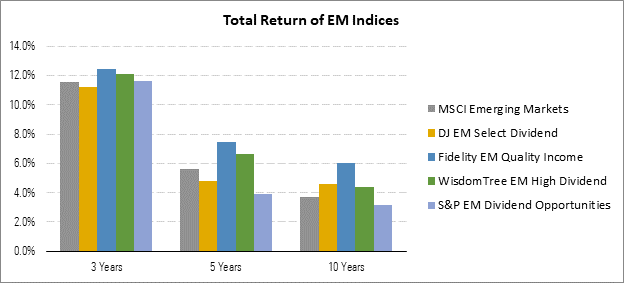
Following a decade of meagre returns, emerging markets equities are starting to catch up. Despite a number of headwinds over the past three years, the MSCI Emerging Markets Index has delivered returns that were almost identical to the MSCI World Index. Meanwhile, since its inception in January 2001, the MSCI Emerging Markets has outperformed the MSCI World by nearly 3.5% per year in annualised terms. This underpins the importance of considering emerging markets funds as core portfolio holdings.
And emerging markets can be particularly interesting for investors seeking dividend income. Looking at MSCI High Dividend Yield Indices - widely accepted barometers for dividend stocks - emerging markets currently offer a yield of 5.3%, around 1.5 percentage points ahead of developed countries.
Typically, dividend strategies involve balancing current income yield with the ability of the portfolio to deliver long-term growth, which can be paid out as income. However, strategies can vary from fund-to-fund – some look to maximise yield, while other favour lower but stable income for the long-term
This means that investors must conduct due diligence to determine what strategy suits them best. To help, we have analysed four European-domiciled dividend ETFs in the Morningstar Global Emerging Markets category.
| Name | Ticker | Yield (%) | Fund Size (£m) |
Ongoing Charge (%) |
| iShares EM Dividend ETF | SEDY | 5.6 | 347.5 | 0.65 |
| Fidelity EM Quality Income ETF | FEMQ | 3.7 | 44.0 | 0.50 |
| WisdomTree EM Equity Income ETF | DEMS | 4.2 | 37.1 | 0.46 |
| SPDR EM Dividend Aristocrats ETF | EMDV | 4.9 | 113.6 | 0.55 |
Source: Morningstar Direct 31/12/19
Fidelity Emerging Markets Quality Income ETF
Instead of focusing on dividend yield, this ETF scours the stock universe for highly profitable companies. Candidates are judged on a number of factors including how efficiently they convert revenues to cash and how well and for how long they can service debt obligations.
This approach significantly decreases the probability of investing in companies with shaky profits or mounting debt that can lead to dividend cuts.
The caveat for income-seeking investors is its dividend yield; at 3.7%, it’s the lowest of the group of ETFs we analysed. However, because of its focus on quality companies, the ETF has strong potential to deliver solid long-term total returns, that is, reinvested dividends plus capital appreciation.
Holding nearly 180 stocks, the fund is well-diversified and country and sectors weights are capped to match those of the broad emerging markets index.
WisdomTree Emerging Markets Equity Income ETF
The WisdomTree ETF has a very broad and diversified portfolio that seeks companies paying the highest dollar amount of dividends. While this may sound a bit confusing, it is actually very simple: at the starting point in building the portfolio, companies are assigned the standard weight that they have in a mainstream equity index-tracking fund. The weightings are then increased or decreased depending on the dividend yield they offer.
This approach typically favours companies in the utilities, materials and energy sectors, as these routinely come with yields above the market average. Currently, the combined weight of these sectors in the WisdomTree ETF is around 45%, compared to an average of 13% among funds in the same Morningstar Category.
In Morningstar’s Analyst Ratings process, we typically favour quality screening of companies over basic yield-seeking. However, we cut some slack to yield-seeking strategies that are highly diversified. This is the case with the Wisdom Tree ETF, which holds nearly 600 stocks.
This helps to spread out the risk of any dividend cuts in the future. Compared to the other three funds, the WisdomTree ETF stands out with the lowest fee at 0.46%.
SPDR S&P Emerging Markets Dividend Aristocrats ETF
The SPDR ETF offers high yield by weighting its stocks according to the dividend they pay. Unlike the WisdomTree ETF, however, the size of the company is not considered, which tends to mean more smaller companies in the portfolio.
This approach maximizes the current yield but can limit the potential for future returns. This is because when companies distribute most of their earnings, they have less to invest in new projects.
To avoid dividend traps, SPDR requires at least three uninterrupted years of stable profits and dividend payments. While this is not foolproof, it does help improve the overall quality of the portfolio and reduce the chance of investing in potential dividend cutters.
Having only 100 stocks, performance could be at some risk from sharp losses from individual companies. To address this, SPDR caps the weighting towards single stocks, sectors and countries at 3%, 25% and 25% respectively.
iShares EM Dividend ETF
The iShares’s ETF is a relatively concentrated portfolio of 100 high-yielding stocks. There is some minimal payment capacity screening in place, such as maximum payout ratio, but the primary objective of the strategy is to deliver the maximum current yield with the stocks selected irrespective of quality characteristics and size.
This makes the strategy particularly vulnerable to dividend traps; a situation where stocks show high expected dividend yields that are too good to be true. In many cases, the reason for the high yield is explained by a drop in the price of the stock as the market anticipates troubles with the business.
As the fund does not weight companies by their market capitalisation, it has a tilt towards small- and mid-cap companies, which can result in higher volatility. However, to limit concentration risk, country exposures are capped at 25%.
How Have the Funds Performed?
Over the past five years, two-thirds of the returns of the MSCI Emerging Markets Index have been delivered by three sectors – financials, technology and communication services. Yet while all dividend-focused indices have had similar exposure to these sectors, their returns have differed. The Fidelity index, for example, has outpaced the S&P index by about 2.2% a year in the past decade.

Source: Morningstar Direct, S&P Dow Jones Indices. data as of 31/12/2019
Focusing on quality when picking dividend stocks has been a superior strategy over the long-term, but it may underperform over short periods relative to strategies that focus on maximising current income. This is why investors need to have a clear view of their investment goal and horizon to select the appropriate product.
The Fidelity Emerging Markets Quality ETF stands as an interesting option for investors seeking a steady dividend income stream over the long-term, while the WisdomTree and iShares ETFs would be more suited for investors wanting to maximise dividend income over short periods.




























